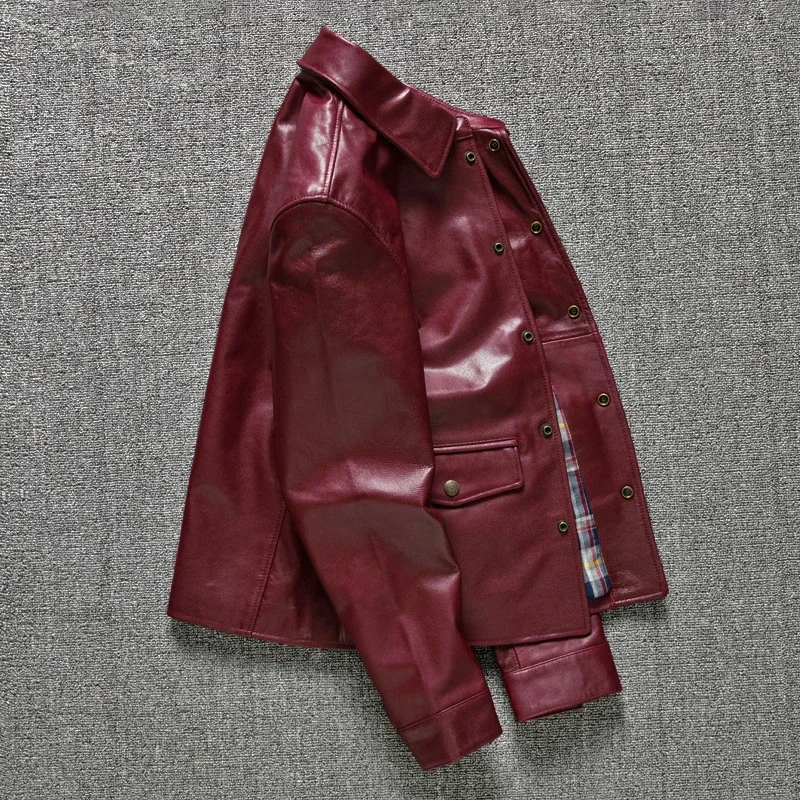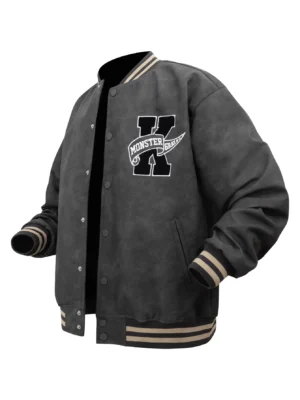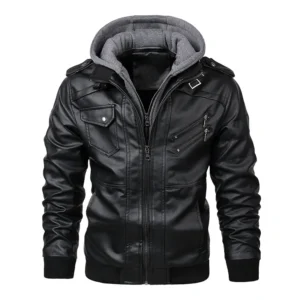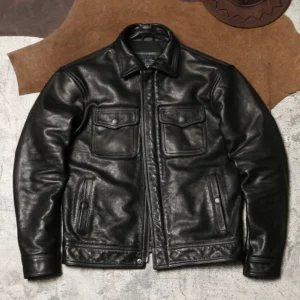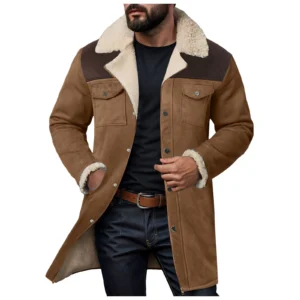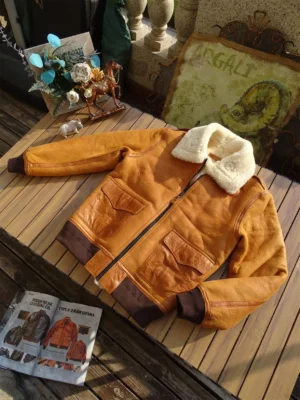The Short Answer: Yes, You Absolutely Should Protect Your Leather Jacket
If you’re wondering whether your leather jacket needs protection, the answer is a resounding yes. Leather jackets are investments that deserve proper care to maintain their appearance, durability, and value over time.
Unlike synthetic materials, leather is a natural material that continues to react to its environment long after it’s been crafted into your favorite jacket. Without proper protection:
- Your jacket becomes vulnerable to water damage, leading to stains and warping
- The leather can dry out, causing unattractive cracking and reducing flexibility
- Colors may fade and the overall appearance will deteriorate much faster
Research shows that properly protected leather jackets can last decades, while unprotected ones might show significant wear within just a few years. Throughout this guide, we’ll explore everything you need to know about comprehensive leather coat care to keep your jacket looking its best for years to come.
Why Protecting Your Leather Jacket is Essential: Understanding the Risks
Water Damage: Leather’s Natural Enemy
Leather and water don’t mix well. When unprotected leather gets wet, it absorbs moisture, which can lead to water spots, stiffening, and even mold growth in extreme cases. The natural oils that keep leather supple can be washed away, leaving it vulnerable to drying out afterward.
Drying and Cracking: The Silent Destroyer
Perhaps the most common form of leather damage is drying and cracking. Leather contains natural oils that maintain its flexibility. Over time, these oils evaporate, causing the material to stiffen and eventually crack. Preventing leather coat cracks is essential for maintaining both appearance and structural integrity.
Stains and Discoloration
Unprotected leather readily absorbs oils—including those from your hands and skin. Daily handling can leave dark patches on lighter leathers, while exposure to sunlight causes fading in all leather types. Food, drinks, and environmental contaminants can create permanent stains without proper protection.
Scratches and Scuffs
Leather’s surface is surprisingly delicate. Without protective treatments, even minor contact with rough surfaces can leave visible marks that accumulate over time, diminishing your jacket’s appearance.
Loss of Suppleness and Comfort
Quality leather should feel soft and mold to your body over time. Without protection, it becomes increasingly stiff and uncomfortable, losing the very qualities that make leather jackets so desirable.
When you consider that quality leather jackets represent a significant investment, protection becomes not just about aesthetics but about preserving both monetary and sentimental value.
Types of Leather Protection: Choosing the Right Shield for Your Jacket
Different leather protection products serve different purposes. Understanding each type helps you select the most appropriate option for your specific jacket.
Leather Conditioners
Leather conditioners are the foundation of any protection regimen:
– They replenish natural oils lost through evaporation and use
– Quality conditioners penetrate deep into the leather fibers
– They restore suppleness and prevent cracking
– Best ingredients include lanolin, beeswax, and natural oils like mink or neatsfoot
– Avoid products with heavy petroleum distillates that can damage leather over time
Waterproofing Solutions
Keeping moisture at bay is crucial for leather longevity:
– Waterproofing sprays create an invisible barrier that repels water
– Waxes provide more robust protection but may slightly darken the leather
– Water-resistant treatments allow the leather to breathe while repelling light moisture
– Fully waterproof treatments offer maximum protection but may reduce breathability
Learning how to waterproof leather coat materials properly can dramatically extend their lifespan, especially if you live in a rainy climate or frequently wear your jacket in adverse conditions.
UV Protectants
Sun damage is often overlooked but can be devastating to leather:
– UV protectants shield leather from harmful sun rays
– They prevent fading, particularly important for colored leathers
– Many modern formulations combine UV protection with conditioning properties
All-in-One Solutions
For convenience, many manufacturers offer combination products:
– These typically include conditioning, water resistance, and UV protection
– They’re ideal for regular maintenance
– However, they may not provide the specialized care needed for neglected leather
The right protection products for your jacket will depend on its specific leather type and your typical wearing conditions. For example, mens leather shearling coats require different care approaches than smooth leather jackets due to their unique construction.
How to Protect Your Leather Jacket: A Step-by-Step Application Guide
Proper application technique is just as important as choosing the right products. Follow these steps for optimal results:
Preparation
- Clean your jacket thoroughly using a leather-appropriate cleaner
- Allow the jacket to dry completely at room temperature (never use heat)
- Test any new product on an inconspicuous area first
- Work in a well-ventilated area, especially when using spray products
- Gather soft, lint-free cloths for application
Applying Leather Conditioner
- Apply a pea-sized amount of conditioner to a clean cloth
- Work in small circles, covering one section at a time
- Use light pressure to help the product penetrate the leather
- Allow 15-20 minutes for initial absorption
- Buff away any excess with a clean cloth
- Let the jacket rest for 24 hours before wearing
Expert tips on properly conditioning leather coats suggest that less is more—multiple light applications are better than one heavy coat.
Using Waterproofing Sprays
- Hold the can 6-8 inches away from the leather surface
- Apply in light, even sweeps while keeping the can moving
- Cover the entire jacket with two thin layers rather than one thick layer
- Allow at least 30 minutes between coats
- Let the jacket dry completely for at least 24 hours
Applying Protective Waxes/Balms
- Scoop a small amount of wax or balm with your fingertips
- Warm it between your hands to soften
- Apply in thin layers using small circular motions
- Pay special attention to seams and high-contact areas
- Allow to absorb for at least an hour
- Buff gently to remove excess and create a subtle sheen
Remember that overapplication can cause buildup and actually attract dirt, so apply sparingly and increase as needed.
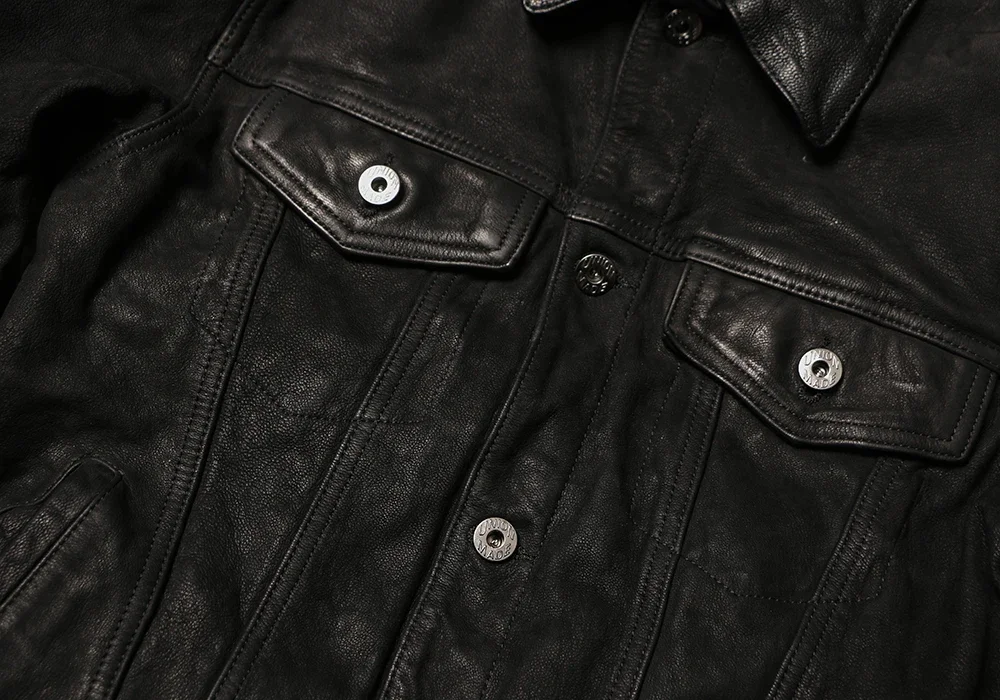
Frequency of Protection: How Often Should You Treat Your Jacket?
The frequency of leather protection depends on several factors including usage, climate, and leather type.
General Guidelines
- Conditioning: Every 3-6 months for regularly worn jackets
- Waterproofing: Every 2-3 months during rainy seasons
- Deep conditioning: Annually or when leather feels noticeably dry
Environmental Factors Affecting Frequency
- Dry climates require more frequent conditioning to prevent moisture loss
- Humid environments may need less conditioning but more frequent mold prevention
- Urban environments with pollution require more regular cleaning and protection
- Frequent exposure to sunlight demands more UV protection
Signs Your Jacket Needs Protection
Your leather will tell you when it needs attention:
– The surface feels dry or rough to the touch
– Water no longer beads up but soaks in quickly
– The leather looks dull or has lost its luster
– You notice stiffness when putting it on
– Light scratches don’t buff out easily
Long-term leather coat care involves developing a consistent maintenance schedule, but also being responsive to these visual and tactile cues.
Leather Type Matters: Tailoring Protection to Your Jacket’s Material
Different leather types have unique needs that require specific care approaches.
Full-Grain and Top-Grain Leather
These highest quality leathers have natural variations and pores:
– Condition regularly to maintain natural oils
– Use dedicated full-grain conditioners that penetrate deeply
– Can handle slightly heavier conditioner application
– Develop an attractive patina over time with proper care
Suede and Nubuck
These brushed leathers have a soft, textured surface:
– Require specialized suede protectors, not regular leather conditioners
– Need gentle brushing rather than rubbing during application
– Often benefit from specialized suede brushes for maintenance
– Should never be treated with oil-based products
Patent Leather
With its glossy, sealed finish, patent leather requires different care:
– Needs minimal conditioning as it’s already sealed
– Benefits from specialized patent leather products
– Should be wiped clean regularly with a damp cloth
– Requires products that maintain shine without causing stickiness
Corrected Grain/Finished Split/Bonded Leather
These more processed leathers have different characteristics:
– Need gentler products with less penetration
– Benefit from surface protectants rather than deep conditioners
– May have manufacturer-specific care recommendations
– Often have protective coatings that need maintenance
Understanding the differences between genuine leather vs. faux leather and other variants helps you select appropriate care products. Similarly, specialized types like those used in shearling coats require specific approaches to maintain both the leather and fur components.
Essential Leather Jacket Care Beyond Protection Products
Protection products are just one aspect of comprehensive leather care. These complementary practices are equally important:
Proper Cleaning Techniques
- Dust and surface dirt should be removed weekly with a soft cloth
- Address spills immediately by blotting (never rubbing)
- Use leather-specific cleaners for deeper cleaning
- Always clean before applying any protectant
- Test cleaners on inconspicuous areas first
Correct Storage Practices
- Store on padded hangers to maintain shape
- Avoid plastic covers which trap moisture; use breathable cloth covers instead
- Keep away from direct sunlight and heat sources
- Maintain moderate humidity in storage areas
- Stuff sleeves lightly with acid-free paper to prevent creasing
Expert guide on properly storing leather coats emphasizes that proper storage prevents more damage than many realize.
Handling Wet Leather Emergencies
If your jacket gets soaked:
– Blot excess moisture with towels
– Allow to dry naturally at room temperature
– Keep away from direct heat sources
– Apply conditioner after completely dry
– Reshape while drying if needed
Managing Minor Stains and Scratches
For small imperfections:
– Address stains immediately with appropriate leather cleaners
– Use leather-specific spot treatments
– Buff minor scratches with a soft cloth
– Consider leather touch-up products for color matching
– Know when to seek professional help for significant damage
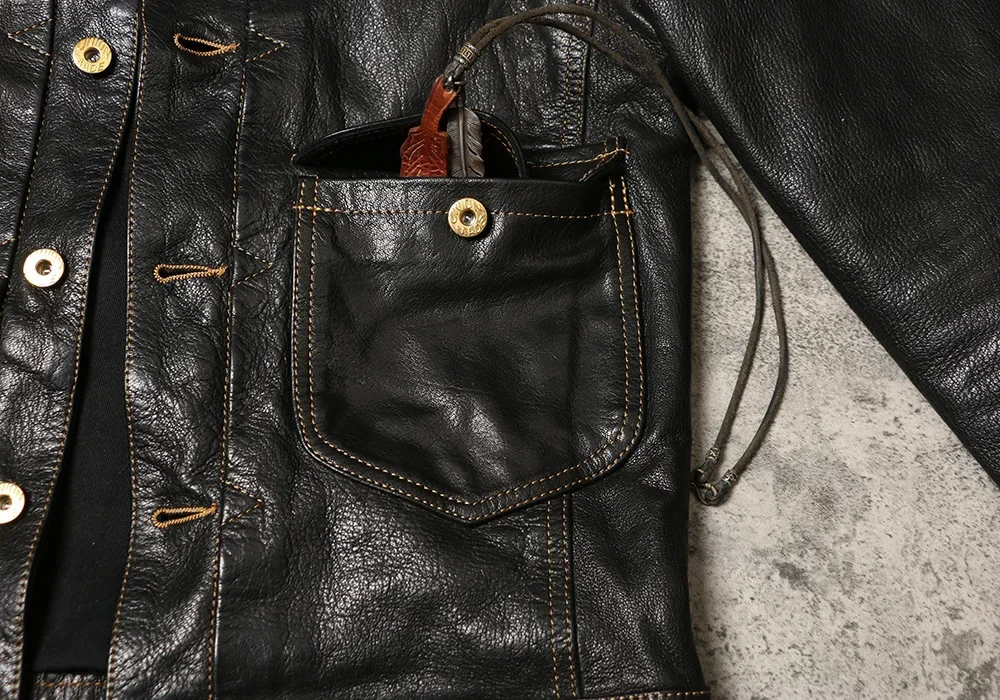
Mens Leather Coat, Mens Long Leather Coat
Price range: $225.22 through $235.58 Select options This product has multiple variants. The options may be chosen on the product pageMens Black Leather Coat, Mens Leather Coat
Price range: $181.52 through $197.20 Select options This product has multiple variants. The options may be chosen on the product pageMens Brown Leather Coat, Mens Leather Coat
$846.94 Select options This product has multiple variants. The options may be chosen on the product pageMens Shearling Coat, Mens Sheepskin Coat
$888.08 Select options This product has multiple variants. The options may be chosen on the product page- Price range: $96.28 through $130.88 Select options This product has multiple variants. The options may be chosen on the product page
Mens Shearling Coat, Mens Sheepskin Coat
$2,257.19 Select options This product has multiple variants. The options may be chosen on the product page
Common Mistakes to Avoid in Leather Jacket Care
Even with good intentions, these common mistakes can damage your leather jacket:
Using household soaps or detergents: These strip natural oils and damage the leather’s pH balance. Always use leather-specific cleaners.
Applying too much conditioner: Over-conditioning causes buildup, attracting dirt and potentially darkening the leather. Use sparingly and increase as needed.
Drying wet leather with heat: Heat causes leather to shrink, crack and warp. Always air dry at room temperature away from heat sources.
Storing in plastic: Plastic traps moisture, leading to mold and mildew. Use breathable cotton garment bags instead.
Using silicone-based products: While they create an immediate shine, silicone can build up and prevent the leather from breathing, leading to damage over time.
Ignoring manufacturer’s instructions: Different leather finishes may have specific care requirements. Always check labels or documentation.
Using colored polish on unmatched leather: This can cause blotchy discoloration. Always match products to your specific leather color.
Neglecting regular maintenance: Waiting until damage is visible means you’ve waited too long. Preventative care is always more effective than repair.
Learning to clean leather coat at home properly helps you avoid these pitfalls while maintaining your jacket’s appearance.
What to Look For in Leather Protection Products (And What to Be Cautious Of)
Beneficial Ingredients
Quality leather care products typically contain:
– Natural oils like mink oil, neatsfoot oil, or jojoba
– Beeswax for water resistance and conditioning
– Lanolin for moisture balance
– Carnauba wax for shine and protection
– Natural UV inhibitors
Red Flags in Product Formulations
Be cautious of products containing:
– High alcohol content that can dry leather
– Heavy petroleum distillates that may degrade stitching
– Silicone that builds up over time
– Artificial fragrances that may contain harmful chemicals
– Ammonia or bleach components
Evaluating Quality Beyond Marketing Claims
Look for products that:
– Specify the leather types they’re suitable for
– Have transparency about ingredients
– Provide clear application instructions
– Have established reputations from leather craftspeople
– Offer realistic claims about results
Understanding the different types of leather cleaners for coats helps you select products that clean effectively without causing damage. This is especially important for specialty items like black leather coats that may show product residue more visibly than other colors.
Frequently Asked Questions About Protecting Leather Jackets
Can I use olive oil or other household oils to condition my leather jacket?
While household oils might provide temporary softening, they often go rancid over time, causing odors and attracting dirt. They can also oversaturate and stain leather. Stick with products specifically formulated for leather care.
How can I tell if my jacket is genuine leather?
Genuine leather has natural variations in texture, a distinctive smell, and often shows small imperfections. It feels warm to the touch and absorbs small amounts of moisture. Synthetic leather typically has a uniform texture, chemical smell, and perfect appearance.
What’s the difference between leather cleaners and conditioners?
Cleaners remove dirt, oil, and residue from the leather surface without adding moisture. Conditioners replenish oils and moisture after cleaning. Using them in the correct order—clean, then condition—ensures that conditioners penetrate clean leather rather than getting trapped in surface dirt.
Can I waterproof suede and nubuck the same way as smooth leather?
No. Suede and nubuck require specialized waterproofing products that maintain their texture. Regular leather waterproofing products can mat down the nap and ruin the appearance of these textured leathers.
How long does leather protection last?
Protection duration varies based on product type, wear frequency, and environmental conditions. Generally:
– Conditioners: 1-6 months
– Waterproofing: 1-3 months in wet conditions
– UV protection: 2-3 months with regular sun exposure
What should I do if my jacket gets caught in heavy rain?
Allow it to dry naturally at room temperature away from heat sources. Once completely dry, apply conditioner to restore moisture balance and prevent stiffening. For serious soaking, consider professional treatment.
Is it possible to over-condition leather?
Yes. Over-conditioning can saturate leather, causing it to become too soft, stretchy, and potentially darkening the color. It can also create a tacky surface that attracts dirt. Follow product instructions and use sparingly.
Oiling your leather jacket properly is a delicate balance—too little leaves it vulnerable, too much can cause damage.
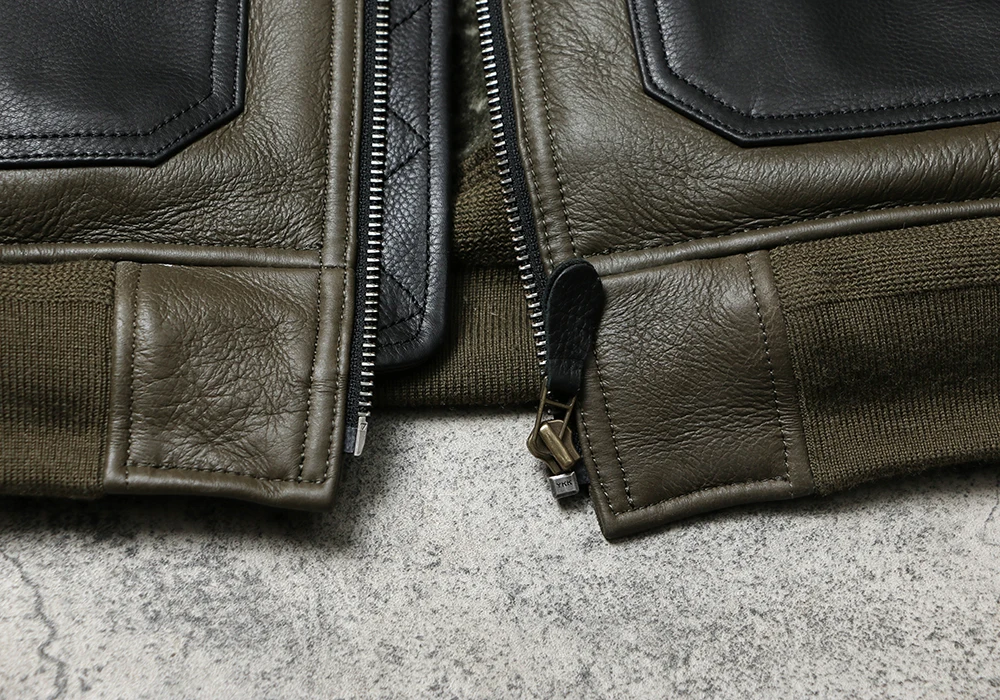
Conclusion: Investing in Protection is Investing in Your Leather Jacket’s Future
Protecting your leather jacket isn’t just recommended—it’s essential for preserving its beauty, comfort, and longevity. By understanding the risks, selecting appropriate products, and following proper application techniques, you can dramatically extend your jacket’s life.
Regular conditioning, waterproofing, and general care don’t just prevent damage—they enhance the leather’s natural characteristics, allowing it to develop character while remaining structurally sound. When you consider that quality brown leather coats and other leather jackets can last decades with proper care, the time invested in protection delivers tremendous returns.
Your leather jacket represents both a financial investment and a style statement. With the knowledge you’ve gained from this guide, you can now ensure it remains a cherished part of your wardrobe for years to come. Start implementing these protection practices today—your future self will thank you when your jacket still looks amazing years from now.

